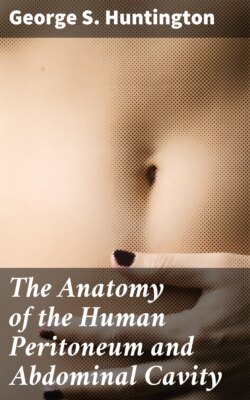The Anatomy of the Human Peritoneum and Abdominal Cavity

Реклама. ООО «ЛитРес», ИНН: 7719571260.
Оглавление
George S. Huntington. The Anatomy of the Human Peritoneum and Abdominal Cavity
The Anatomy of the Human Peritoneum and Abdominal Cavity
Table of Contents
PREFACE
INTRODUCTION
PART I. ANATOMY OF THE PERITONEUM AND ABDOMINAL CAVITY
COMPARATIVE ANATOMY OF FOREGUT AND STOMACH
STOMACH
INTESTINE
PART II. ANATOMY OF THE PERITONEUM IN THE SUPRA-COLIC COMPARTMENT OF THE ABDOMEN
PART III. LARGE AND SMALL INTESTINE, ILEO-COLIC JUNCTION AND CÆCUM
PART IV. MORPHOLOGY OF THE HUMAN CÆCUM AND VERMIFORM APPENDIX
INDEX
Footnote
Отрывок из книги
George S. Huntington
Considered from the Standpoint of Development and Comparative Anatomy
.....
Both the somatic and the splanchnic leaf of the mesoderm consist at first solely of a layer of flattened epithelial cells, the mesothelium. But very early this tissue is increased to form a massive layer by direct development from the mesothelium. The new mesodermal cells thus produced constitute the mesenchyma, which includes the whole of the mesoderm of the embryo except the mesothelial lining of the cœlom. The cells of the mesenchyma, connected with each other and with the mesothelial cells by protoplasmic processes, are not as close together as in an epithelium and do not form a continuous membrane. By migration and multiplication a large mass of mesodermal tissue is produced which fills the entire space between the mesothelium and the primary germ layers. The mesenchymal tissue between the mesothelium and the ectoderm forms the mass of the skeletal, muscular and vascular systems. The mesenchymal tissue between the mesothelium and the entoderm forms an important constituent of the alimentary canal and of its appendages. The entoderm furnishes the internal epithelial lining of the tube upon which the performance of the specific physiological function of the entire apparatus depends. This epithelial tube is covered from without by the splanchnic mesoderm. The mesodermal elements thus added to the enteric entodermal tube consist of connective tissue and muscular fibers. The latter, arranged in the form of circular and longitudinal layers, control the contractility of the tube and regulate the propulsion of the contents. The connective tissue of the splanchnic mesoderm appears as an intermediate layer uniting the epithelial lining and the muscular walls. Situated thus between the mucous and muscular coats of the intestine this layer is known as the submucosa. It contains, imbedded in its tissue, the glandular elements of the intestine derived from the entodermal epithelium, and the blood vessels, lymphatics and nerves. The second chief function of the splanchnic and somatic mesoderm is the production of the serous membrane investing the body cavity and its contents from the mesothelium lining the primitive cœlom. This mesothelial tissue, differentiated as a layer of flattened cells, lines the interior of the body cavity and covers the superficial aspect of the enteric tube. By subsequent partition of the common cœlom the great serous membranes of the adult, the pleuræ, pericardium and peritoneum, are developed from it.
Fig. 32.—Schematic diagrams, illustrating the vertebral mesentery. A. earlier; B. later condition. (Minot.)
.....